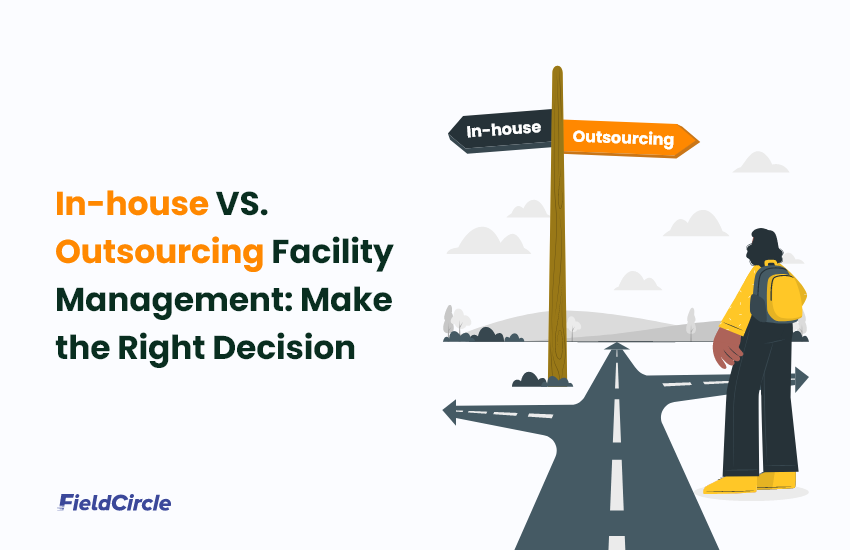In-house VS. Outsourcing Facility Management: Make the Right Decision

As a business leader, you must have faced the dilemma of adding more positions for cleaning, security, or maintenance staff or relying on a Facility Management (FM) company for the upkeep of your facility. While some business owners may prefer to handle these tasks themselves to ensure they are executed perfectly, there may come a point where this is not feasible due to time constraints. Both options have their pros and cons, so it’s essential to evaluate what each means for your business.
Facility management is a critical aspect of business operations as it plays a crucial role in ensuring the smooth and efficient functioning of various facilities, including corporate offices, manufacturing plants, hospitals, and educational institutions. This multifaceted discipline covers a diverse range of activities, such as maintenance, safety, security, space planning, and sustainability initiatives, all aimed at optimizing the use of physical assets to support an organization’s core functions.
Effective management of facilities is indispensable for organizations of all sizes and industries, as it directly impacts their operational efficiency, cost-effectiveness, and overall well-being. Facilities represent a substantial investment for any business, and their proper management is vital for several reasons and managing it efficiently helps control costs, maintain assets, boost employee productivity, ensure compliance and safety, and ensure business continuity in unforeseen events.
With the evolution of cloud based facility management software, the choice has become even more initmidating. Organizations must make an important decision regarding how they oversee their facilities. This article explores the key considerations when deciding between creating in-house teams and outsourcing operations, shedding light on the advantages and disadvantages of each approach to help businesses make an informed choice.
What is In-house Facility Management?
Deploying In-house teams to manage facilities is a practice where an organization uses its own resources and staff to manage its facilities and infrastructure. This includes hiring and maintaining a dedicated team of professionals responsible for the maintenance and oversight of all the organization’s physical assets, such as buildings, equipment, security, and environmental sustainability.
When considering hiring an in-house crew, two critical factors are security and convenience. Having your own crew that works directly for your company provides greater control and customization, eliminating the need to deal with a third-party vendor. Additionally, in-house crews can respond quickly to urgent requests, providing time-sensitive services.
However, there are also potential downsides to keeping in-house teams. It’s important to note that the quality of work performed by an in-house team may not always meet the required standards. Additionally, the hiring, training, and equipping such a team can be a significant expense for the organization, regardless of the frequency of their services. In the following section of this article, we will try to understand the pros and cons of In-house Facility management in detail
What are the Advantages of In-house Facility Management?
Listed below are some advantages of in-house teams:
· Control and Oversight:
One of the primary advantages of this approach is the high level of control and oversight an organization maintains over its facilities. With an internal team, businesses can align their maintenance needs closely with their specific needs, goals, and corporate culture.
· Consistent Quality and Standards:
In-house teams allow organizations to set and maintain consistent quality and service standards. Since the company directly employs the team, they can ensure that their policies, procedures, and performance align with the organization’s values and expectations.
· Direct Interaction with Employees:
An in-house team facilitates direct interaction and communication between facility managers and the organization’s employees. This direct relationship driven by a facility management app can lead to better understanding of employee needs and preferences, which can be invaluable for tailoring facility services to optimize employee satisfaction and productivity.
· Customization and Flexibility:
In-house teams can quickly adapt to the changing needs and priorities of the organization. They can implement customized solutions and strategies to address specific challenges and opportunities that arise within the company.
· Long-term Alignment:
Teams within the organization allow for better alignment with the organization’s long-term goals and strategic objectives. The deployed team can work closely with other departments to ensure that facility-related decisions support the overall mission and vision of the company.
· Brand and Reputation Management:
When in-house maintenance operations are conducted, the organization has direct control over how its facilities are maintained and operated. This can be crucial for brand and reputation management, ensuring that the organization’s physical spaces reflect its desired image and values.
· Data and Performance Analysis:
Teams within an organization can collect and analyze facility performance data to make informed decisions and drive continuous improvement. They have immediate access to relevant data and can use it to optimize processes and resource allocation.
· Integration with Organizational Culture:
A team maintained by your organization can be integrated seamlessly into the organization’s culture, ensuring that the team’s goals and practices align with the broader cultural values and norms of the company.
· Enhanced Security and Confidentiality:
In specific industries, such as healthcare or finance, having in-company teams can provide an extra layer of security and confidentiality since the team is directly employed and aligned with the organization’s security policies.
What are the Disadvantages of In-house Facility Management
Listed below are the disadvantages of teams maintained within the organization:
· Costs and Resource Allocation
One of the primary challenges of an in-company team is the financial burden it places on the organization. Hiring, training, and maintaining a dedicated team, along with necessary equipment and resources, can be costly and may divert resources from the organization’s core business activities.
· Limited Expertise and Skillset
Teams within your organization may sometimes have limited expertise and skillsets, especially for specialized maintenance operations. The organization may face challenges in keeping up with rapidly evolving industry best practices and technologies without significant investments in training and development.
· Increased Workload for Existing Employees
If your facility operations are looked after by your in-company team, it may increase the workload for existing employees needing to participate in facility-related tasks. This can be a significant distraction from their primary responsibilities, potentially affecting overall productivity and job satisfaction.
Ultimately, the decision to opt for in-house teams should consider the organization’s specific needs, available resources, and long-term strategic goals. While it offers control and direct interaction, it comes with the responsibilities of resource allocation and maintaining a capable in-house team. In contrast, outsourcing maintenance tasks is an alternative approach that presents its own set of advantages and disadvantages, as discussed in the next section.
What does Outsourcing Facility Management Mean?
Outsourcing operations involves contracting out the management and maintenance of an organization’s physical assets and facilities to an external service provider. This practice is a current trends in facilities management allows the organization to entrust responsibilities such as building maintenance, security, janitorial services, and space planning to a third-party service provider rather than relying on an in-house team.
Signing a service-level agreement (SLA) or a contract that outlines the scope of services, performance expectations, and terms of the arrangement are typically critical parts of outsourcing. The external service provider assumes responsibility for various aspects of facility operations, enabling the organization to focus on its core business activities.
The benefits of outsourcing operations are immediate and tangible. Professional commercial cleaning and janitorial companies usually assign tasks in batches to maximize time efficiency.
This approach is often chosen by organizations seeking to reduce costs, improve efficiency, access specialized expertise, and enhance overall service quality while minimizing the administrative burden of managing facilities internally. Outsourcing can be applied to many facilities, including office buildings, manufacturing plants, retail stores, hospitals, schools, and more. In the following section of this article, we will try to understand the pros and cons of outsourcing in detail.
What are the Advantages of Outsourcing Facility Management Operations?
Listed below are some advantages of outsourcing maintenance tasks:
· Cost Savings:
One of the primary advantages of outsourcing is the potential for cost savings. External service providers often have economies of scale, allowing them to spread costs across multiple clients. This can result in lower overall service costs, as the provider can invest in specialized equipment, technology, and expertise more efficiently.
· Expertise and Specialization:
Companies in the facility maintenance industry are often staffed with specialists who bring expertise in various aspects of maintenance activities, such as HVAC maintenance, security, sustainability, and space planning. This expertise can lead to more effective and efficient operations, ensuring facilities are well-maintained and comply with industry best practices.
· Focus on Core Business:
By outsourcing these operations, organizations can concentrate on their core business activities, improving productivity and competitiveness. Managing facilities can be complex and time-consuming, and outsourcing allows organizations to offload this responsibility.
· Access to Technology and Innovation:
Providers are typically up-to-date with the latest technologies and innovations. This ensures that facilities benefit from the most advanced and efficient solutions, from energy-saving systems to smart building technologies.
· Scalability and Flexibility:
Outsourcing allows organizations to scale their management services up or down according to changing needs without the challenges of hiring or laying off in-house staff. This scalability can be particularly valuable for businesses with fluctuating facility requirements.
· Risk Mitigation:
Outsourcing facility management services often assume responsibility for compliance, safety, and regulatory issues, reducing the organization’s exposure to risks and liabilities associated with facility operations.
· Reduced Administrative Burden:
Managing an in-house team involves administrative overhead, including hiring, training, payroll, and performance management. Outsourcing shifts this burden to the service provider, allowing the organization to focus on strategic activities.
· Service Level Agreements (SLAs):
Outsourcing your facilities management typically involves the establishment of SLAs, which outline performance expectations and accountability. This ensures the vendor is contractually bound to meet agreed-upon service standards.
· Global Expertise:
Often, service providers may have a global presence and the ability to apply best practices and expertise from various regions and industries, ensuring a well-rounded approach to maintenance activities.
· Focus on Customer Satisfaction:
Most service-providing companies are driven by customer satisfaction and aim to provide high-quality service to maintain their reputation. This commitment to client satisfaction can improve facility performance and end-user experience.
What are the Disadvantages of Outsourcing Facility Management Operations?
Listed below are the disadvantages of deploying external service providers
· Dependence on Vendor Performance:
When an organization considers outsourcing, it becomes dependent on the performance and reliability of the service provider. If the vendor fails to meet service level agreements (SLAs) or quality standards, it can negatively impact the organization’s operations, reputation, and customer satisfaction. Dependence on a third party can also limit the organization’s ability to address issues promptly.
· Potential Loss of Control and Oversight:
Outsourcing can lead to losing direct control and oversight over critical functions. The organization may have limited influence over day-to-day operations, decision-making, and implementing strategies related to the maintenance of the facility. This can be a disadvantage if the organization has specific requirements not adequately addressed by the service provider.
· Communication and Coordination Challenges:
Effective communication and coordination can be more challenging with outsourced maintenance issues. The organization may experience difficulties in aligning the external service provider’s activities with its strategic goals and cultural values. The potential for misunderstandings and misalignment can hinder the smooth operation of facilities.
· Long-term Cost Concerns:
While outsourcing can offer cost savings in the short term, organizations should be mindful of long-term financial considerations. Contractual agreements may include cost escalation clauses or additional charges for extra services, which can impact the cost-effectiveness of the outsourcing arrangement over time.
· Vendor Reliability and Stability:
Organizations must assess the reliability and financial stability of the chosen service provider. If the vendor faces financial or operational difficulties, it could disrupt their services, potentially leading to service interruptions or needing an alternative provider.
Conclusion
The tug-of-war between in-house and outsourcing FM is a critical one that requires a thorough evaluation of an organization’s unique needs, resources, and strategic goals. Each approach comes with its own set of advantages and disadvantages, and the choice should be made after careful consideration of these factors.
The choice between these approaches should be driven by the organization’s specific requirements, budget constraints, and long-term objectives. Regardless of the chosen model, it is crucial to establish clear expectations and communication channels, monitor performance, and regularly assess the effectiveness of the maintenance strategy to ensure that it aligns with the organization’s evolving needs and goals.
Optimize your facility management process with top-notch software that helps you plan and manage your operations with ease and efficiency. Say goodbye to manual processes and hello to streamlined workflows, enhanced productivity, and improved outcomes. Schedule a customized demo by FieldCircle today!


